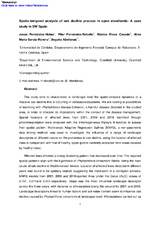Mostrar el registro sencillo del ítem
Spatio-temporal analysis of oak decline process in open woodlands: A case study in SW Spain
| dc.contributor.author | Fernández Habas, Jesús | |
| dc.contributor.author | Fernández Rebollo, Pilar | |
| dc.contributor.author | Rivas Casado, Mónica | |
| dc.contributor.author | García-Moreno, Alma María | |
| dc.contributor.author | Abellanas Oar, B. | |
| dc.date.accessioned | 2024-02-04T15:33:03Z | |
| dc.date.available | 2024-02-04T15:33:03Z | |
| dc.date.issued | 2019 | |
| dc.identifier.issn | 0301-4797 | |
| dc.identifier.uri | http://hdl.handle.net/10396/27037 | |
| dc.description.abstract | This study aims to characterize at landscape level the spatio-temporal dynamics of a massive oak decline that is occurring in dehesas ecosystems. We are looking at possibilities of matching with Phytophthora disease behavior, a harmful disease detected in the studied area, in order to interpret its implications within the context of the disease management. Spatial locations of affected trees from 2001, 2009 and 2016 identified through photointerpretation were analyzed with the inhomogeneous Ripley's K-function to assess their spatial pattern. Multivariate Adaptive Regression Splines (MARS), a non-parametric data mining method, was used to investigate the influence of a range of landscape descriptors of different nature on the proneness to oak decline, using the location of affected trees in comparison with that of healthy spots (points randomly extracted from areas covered by healthy trees). Affected trees showed a strong clustering pattern that decreased over time. The reported spatial patterns align with the hypothesis of Phytophthora cinnamomi Rands. being the main cause of oak decline in Mediterranean forests. Location of affected trees detected in different years was found to be spatially related, suggesting the implication of a contagion process. MARS models from 2001, 2009 and 2016reported Area Under the Curve (AUC) values of 0.707, 0.671and 0.651,respectively. Slope was the most influential landscape descriptor across the three years, with distance to afforestations being the second for 2001 and 2009. Landscape descriptors linked to human factors and soil water content seem to influence oak decline caused by Phytophthora cinnamomi at landscape level. Afforestations carried out as part of the afforestation subsidy program promoted by the European Commission in 1992 could have acted as an initial source of Phytophthora cinnamomi infection. These findings together with the consideration of the spatial and temporal scale of the spreading are essential when planning the management of oak decline in open woodlands. | es_ES |
| dc.format.mimetype | application/pdf | es_ES |
| dc.language.iso | eng | es_ES |
| dc.publisher | Elsevier | es_ES |
| dc.rights | https://creativecommons.org/licenses/by-nc-nd/4.0/ | es_ES |
| dc.source | Fernández‐Habas, J., Fernández‐Rebollo, P., Rivas Casado, M., García-Moreno, M., & Abellanas Oar, B. (2019). Spatio-temporal analysis of oak decline process in open woodlands: a case study in SW Spain. Journal of Environmental Management, 248, 109308. https://doi.org/10.1016/j.jenvman.2019.109308 | es_ES |
| dc.subject | Phytophthora cinnamomi | es_ES |
| dc.subject | Dehesa ecosystems | es_ES |
| dc.subject | Multivariate Adaptive Regression Splines | es_ES |
| dc.subject | InhomogeneousRipley's K-function | es_ES |
| dc.subject | Afforestation | es_ES |
| dc.subject | Disease spread | es_ES |
| dc.title | Spatio-temporal analysis of oak decline process in open woodlands: A case study in SW Spain | es_ES |
| dc.type | info:eu-repo/semantics/article | es_ES |
| dc.relation.publisherversion | http://dx.doi.org/10.1016/j.jenvman.2019.109308 | es_ES |
| dc.rights.accessRights | info:eu-repo/semantics/openAccess | es_ES |

